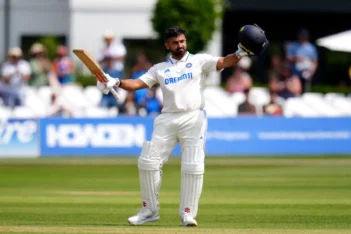Mayank Yadav, Mohsin Khan and Avesh Khan will not play a single match within the the rest of the 12 months and have had main damage points earlier than.
Over the years, India has started producing bowlers who can rock up to the speeds of 140 and over with relative ease. In some cases, even 150. However, most haven’t really been successful. Injury remains the biggest reason for this.
Mohsin Khan was expected to be the next big thing. Yet, 7 years since making his domestic debut, the left-arm pacer has played just 84 professional matches. His last game came in December 2024, and Mohsin has played just 24 matches in the IPL. Mayank Yadav managed to bowl just 121 balls across 2 IPL seasons. The bowler who touched 156 km last year was bowling around 140 a few months ago. Both are currently out injured again.
Akash Deep, who has become a Test regular, seems to be having issues playing back-to-back Test matches. Apart from Mohammed Siraj, India doesn’t seem to have a bowler who can hit the 140 mark and play without fitness issues. Prasidh Krishna has shown promise, but the 29-year-old has missed years of cricket before as well. Why do Indian fast bowlers get injured so often?
In an interview with RevSportz, Steffan Jones, Rajasthan Royals high performance fast bowling coach since 2022, said it’s a multi-faceted problem. He thinks the Indian coaching system has several problems when it comes to fast bowling. Some of them are not just limited to India but worldwide, while others are more prominent in India. Here’s his explanation:
Understanding workload management
The young bowlers, or bowlers in general, bowl too much in the nets. They bowl for two hours at a time because it is still in the mindset that more is better. People still believe in old-fashioned information that you have to do a lot for muscle memory and all that. The modern-day research shows that this is incorrect. That doesn’t impact a skill like fast bowling where it has so many moving parts. A bowler will never repeat internally the same delivery. If you ask a bowler to bowl 50 balls in the nets, they will be 50 different balls. Then the argument of practice makes perfect goes out of the window. Practice makes permanent, not perfect.
What happens is bowlers bowl too many balls, because net bowling, despite people might think it is hard work and sweating, it doesn’t transfer to match-day. It is not intense enough. It is not hard enough for the body to have to adapt to it. 40 percent of injuries happen on match-days. You get injured when you play. There is a disconnect between the amount of balls you bowl in the nets that doesn’t help match-day, those balls are counted as workload management.
Then I get why X cricketers of a certain generation would say workload management is nonsense because at the minute it is not fit for purpose, as you can’t put the same value on net bowling as you would on match-day. The bowlers bowl too many balls in the nets in India.
Lack of sports programs
There is a lack of athleticism in a modern-day cricketer in India simply because it wasn’t provided to them when they were younger. In India, they specialise too early, they go straight to cricket. So, you do pattern overload, you do the same things. You do the same thing all the time and you do a lot of it because it is still in that outdated model of doing more, then you’re going to develop poor habits.
It is very difficult to change the technique of a bowler in India because they have done so much bowling of their current model, which might not be safe and repeatable and effective and efficient. So, in schools you need to get a good physical education, movement programmes.
S&C not up to the mark
I don’t think their strength and conditioning programmes are good enough, it doesn’t quite prepare them for match-days. Cricket is 20 years behind in high-performance models. We are afraid of strength work, we are afraid of overload, simply because of the mindset that you shouldn’t do strength training, shouldn’t do weight training. I agree you shouldn’t do weight training if it is the incorrect weight training.
The bowler’s front foot takes eight times the body weight, the back foot four times the body weight. The forces in bowling are massive. But the difference between bowling and other sports is that those forces happen in a fraction of seconds. It is careful planning, careful programming of training. Here, it is a mixture of running, jumping, and throwing.
How a pacer body works
The fourth one is lack of understanding of human movements and human anatomy in terms of technique. Understanding the technique is how a bowler looks, the mechanics is how it works. How a bowler looks is determined by how strong each muscle is that moves the joint into position because that concept is alien in cricket for some reason.
We search for the perfect technique but there is no such thing as perfect technique. Everyone is different. We can’t be fitting bowlers into a certain technical model when they can’t hold those positions. There is a lack of understanding of biomechanics, what is needed. So, coaching education is needed in India as well.
Editor’s Pick

High Tales

